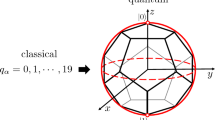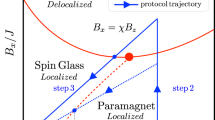Abstract
Quantum algorithms hold the promise of solving certain computational problems dramatically faster than their classical counterparts. The latest generation of quantum processors with ~50 qubits are expected to be at the brink of outperforming classical computers. However, due to the lack of fault tolerance, the qubits can be operated for only a few time steps, making the quantum circuits shallow in depth. Variational quantum algorithms are leading candidates in the effort to find shallow-depth quantum algorithms that outperform classical computers. Here we consider the task of computing the mean values of multi-qubit observables, which is a cornerstone of variational quantum algorithms for optimization, machine learning and the simulation of quantum many-body systems. We develop sub-exponential time classical algorithms for solving the quantum mean value problem for general classes of quantum observables and constant-depth quantum circuits. In the special case of geometrically local two-dimensional quantum circuits, the runtime of our algorithm scales linearly with the number of qubits. Our results demonstrate that appropriate choices of circuit parameters such as geometric locality and depth are essential to obtain quantum speed-ups based on variational quantum algorithms.
This is a preview of subscription content, access via your institution
Access options
Access Nature and 54 other Nature Portfolio journals
Get Nature+, our best-value online-access subscription
$29.99 / 30 days
cancel any time
Subscribe to this journal
Receive 12 print issues and online access
$209.00 per year
only $17.42 per issue
Buy this article
- Purchase on Springer Link
- Instant access to full article PDF
Prices may be subject to local taxes which are calculated during checkout

Similar content being viewed by others
Data availability
No datasets were generated or analysed during the current study.
References
Feynman, R. P. Simulating physics with computers. Int. J. Theor. Phys. 21, 467–488 (1982).
Shor, P. W. Polynomial-time algorithms for prime factorization and discrete logarithms on a quantum computer. SIAM Rev. 41, 303–332 (1999).
Rivest, R. L., Shamir, A. & Adleman, L. A method for obtaining digital signatures and public-key cryptosystems. Commun. ACM 21, 120–126 (1978).
Preskill, J. Quantum computing in the NISQ era and beyond. Quantum 2, 79 (2018).
Castelvecchi, D. IBM’s quantum cloud computer goes commercial. Nature 543, 159 (2017).
Arute, F. et al. Quantum supremacy using a programmable superconducting processor. Nature 574, 505–510 (2019).
Peruzzo, A. et al. A variational eigenvalue solver on a photonic quantum processor. Nat. Commun. 5, 4213 (2014).
Kandala, A. et al.Hardware-efficient variational quantum eigensolver for small molecules and quantum magnets. Nature 549, 242–246 (2017).
McClean, J. R., Romero, J., Babbush, R. & Aspuru-Guzik, A. The theory of variational hybrid quantum-classical algorithms. New J. Phys. 18, 023023 (2016).
Nam, Y. et al. Ground-state energy estimation of the water molecule on a trapped-ion quantum computer. npj Quantum Inf. 6, 1–6 (2020).
Schuld, M. & Killoran, N. Quantum machine learning in feature Hilbert spaces. Phys. Rev. Lett. 122, 040504 (2019).
Havlíček, V. et al. Supervised learning with quantum-enhanced feature spaces. Nature 567, 209–212 (2019).
Temme, K., Bravyi, S. & Gambetta, J. M. Error mitigation for short-depth quantum circuits. Phys. Rev. Lett. 119, 180509 (2017).
Li, Y. & Benjamin, S. C. Efficient variational quantum simulator incorporating active error minimization. Phys. Rev. X 7, 021050 (2017).
Endo, S., Benjamin, S. & Li, Y. Practical quantum error mitigation for near-future applications. Phys. Rev. X 8, 031027 (2018).
Otten, M. & Gray, S. K. Recovering noise-free quantum observables. Phys. Rev. A 99, 012338 (2019).
Bonet-Monroig, X., Sagastizabal, R., Singh, M. & O’Brien, T. E. Low-cost error mitigation by symmetry verification. Phys. Rev. A 98, 062339 (2018).
Kandala, A. et al. Extending the computational reach of a noisy superconducting quantum processor. Nature 567, 491 (2019).
Terhal, B. M. & DiVincenzo, D. P. Adptive quantum computation, constant depth quantum circuits and Arthur–Merlin games. Quantum Inf. Comput. 4, 134–145 (2004).
Goldberg, L. A. & Guo, H. The complexity of approximating complex-valued Ising and Tutte partition functions. Comput. Complex. 26, 765–833 (2017).
Markov, I. L. & Shi, Y. Simulating quantum computation by contracting tensor networks. SIAM J. Comput. 38, 963–981 (2008).
Pednault, E. et al. Breaking the 49-qubit barrier in the simulation of quantum circuits. Preprint at https://arxiv.org/pdf/1710.05867.pdf (2017).
Boixo, S., Isakov, S. V., Smelyanskiy, V. N. & Neven, H. Simulation of low-depth quantum circuits as complex undirected graphical models. Preprint at https://arxiv.org/pdf/1712.05384.pdf (2017).
Villalonga, B. et al. Establishing the quantum supremacy frontier with a 281 pflop/s simulation. Quantum Sci. Technol. 5, 034003 (2020).
Aaronson, S. & Chen, L. Complexity-theoretic foundations of quantum supremacy experiments. Preprint at https://arxiv.org/abs/1612.05903 (2016).
Van den Nest, M. Simulating quantum computers with probabilistic methods. Preprint at https://arxiv.org/pdf/0911.1624.pdf (2009).
Eldar, L. & Harrow, A. W. Local Hamiltonians whose ground states are hard to approximate. In 2017 IEEE 58th Annual Symposium on Foundations of Computer Science (FOCS) 427–438 (IEEE, 2017).
Buhrman, H., Cleve, R., De Wolf, R. & Zalka, C. Bounds for small-error and zero-error quantum algorithms. In 40th Annual Symposium on Foundations of Computer Science 358–368 (IEEE, 1999).
de Wolf, R. A note on quantum algorithms and the minimal degree of epsilon-error polynomials for symmetric functions. Preprint at https://arxiv.org/pdf/0802.1816.pdf (2008).
Barvinok, A. Combinatorics and Complexity of Partition Functions Vol. 276 (Springer, 2016).
Erdős, P. & Lovász, L. Problems and results on 3-chromatic hypergraphs and some related questions. In Colloqua Mathematica Societatis Janos Bolyai 10. Infinite and Finite Sets, Keszthely (Hungary) (Citeseer, 1973).
Mann, R. L. & Bremner, M. J. Approximation algorithms for complex-valued ising models on bounded degree graphs. Quantum 3, 162 (2019).
Kim, I. H. Holographic quantum simulation. Preprint at https://arxiv.org/pdf/1702.02093.pdf (2017).
Kim, I. H. Noise-resilient preparation of quantum many-body ground states. Preprint at https://arxiv.org/pdf/1703.00032.pdf (2017).
Boixo, S. et al. Characterizing quantum supremacy in near-term devices. Nat. Phys. 14, 595–600 (2018).
Bouland, A., Fefferman, B., Nirkhe, C. & Vazirani, U. On the complexity and verification of quantum random circuit sampling. Nat. Phys. 15, 159–163 (2019).
Movassagh, R. Quantum supremacy and random circuits. Preprint at https://arxiv.org/pdf/1909.06210.pdf (2019).
Vidal, G. Efficient classical simulation of slightly entangled quantum computations. Phys. Rev. Lett. 91, 147902 (2003).
Yoran, N. & Short, A. J. Classical simulation of limited-width cluster-state quantum computation. Phys. Rev. Lett. 96, 170503 (2006).
Jozsa, R. On the simulation of quantum circuits. Preprint at https://arxiv.org/pdf/quant-ph/0603163.pdf (2006).
Schollwöck, U. The density-matrix renormalization group in the age of matrix product states. Ann. Phys. 326, 96–192 (2011).
Beals, R., Buhrman, H., Cleve, R., Mosca, M. & De Wolf, R. Quantum lower bounds by polynomials. J. ACM 48, 778–797 (2001).
Kahn, J., Linial, N. & Samorodnitsky, A. Inclusion–exclusion: exact and approximate. Combinatorica 16, 465–477 (1996).
Linial, N. & Nisan, N. Approximate inclusion–exclusion. Combinatorica 10, 349–365 (1990).
Aliferis, P., Gottesman, D. & Preskill, J. Accuracy threshold for postselected quantum computation. Quantum Inf. Comput. 8, 181–244 (2008).
Acknowledgements
We thank R. Koenig and K. Temme for helpful discussions. R.M. thanks A. Barvinok for discussions. D.G. acknowledges the support of the Natural Sciences and Engineering Research Council of Canada (NSERC) under Discovery grant no. RGPIN-2019-04198. D.G. is a CIFAR fellow in the Quantum Information Science programme and is also supported in part by IBM Research. S.B. and R.M. acknowledge the support of the IBM Research Frontiers Institute and funding from the MIT-IBM Watson AI Lab under the project Machine Learning in Hilbert Space.
Author information
Authors and Affiliations
Contributions
All authors contributed important ideas during initial discussions and contributed equally to deriving the technical proofs and writing the manuscript.
Corresponding author
Ethics declarations
Competing interests
The authors declare no competing interests.
Additional information
Peer review information Nature Physics thanks Xiao Yuan and the other, anonymous, reviewer(s) for their contribution to the peer review of this work.
Publisher’s note Springer Nature remains neutral with regard to jurisdictional claims in published maps and institutional affiliations.
Supplementary information
Supplementary Information
Supplementary text and table.
Rights and permissions
About this article
Cite this article
Bravyi, S., Gosset, D. & Movassagh, R. Classical algorithms for quantum mean values. Nat. Phys. 17, 337–341 (2021). https://doi.org/10.1038/s41567-020-01109-8
Received:
Accepted:
Published:
Issue Date:
DOI: https://doi.org/10.1038/s41567-020-01109-8
This article is cited by
-
Covariant quantum kernels for data with group structure
Nature Physics (2024)
-
Boundaries of quantum supremacy via random circuit sampling
npj Quantum Information (2023)
-
The hardness of random quantum circuits
Nature Physics (2023)
-
Integrating Products of Quadratic Forms
Discrete & Computational Geometry (2023)
-
Demonstration of long-range correlations via susceptibility measurements in a one-dimensional superconducting Josephson spin chain
npj Quantum Information (2022)



